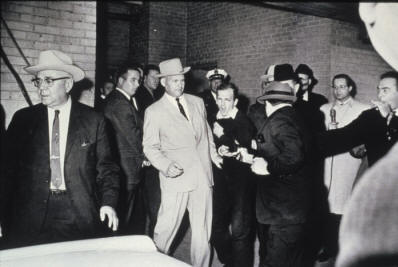Keith Beaty / Toronto Star
Ninalee Craig, 83, is the woman in Ruth Orkin's 1951 photograph "American Girl in Italy." This photo taken on Aug. 12 shows Craig standing next to Orkin's iconic image and wearing the same orange shawl she wore in the photo nearly 60 years ago.
In case you misssed the TODAY Show on NBC today:
By Laura T. Coffey

You know the photo. You’ve seen it a hundred times. A beautiful, statuesque young woman is walking down a street in Florence, Italy. She’s clutching her shawl, and she seems to be moving swiftly. More than a dozen men are staring at her longingly. One of them is grabbing his crotch.
The iconic 1951 image “American Girl in Italy” turns 60 on Monday. As its anniversary approaches, the stunning woman in the photo — Ninalee Craig, now 83 — is speaking up about it. She wants to explain what the photo represents, and what it doesn’t.
“Some people want to use it as a symbol of harassment of women, but that’s what we’ve been fighting all these years,” Craig said in a telephone interview from her home in Toronto. “It’s not a symbol of harassment. It’s a symbol of a woman having an absolutely wonderful time!”
Back in 1951, Craig was a carefree 23-year-old who had chucked her job in New York and secured third-class accommodations on a ship bound for Europe. She spent more than six months making her way through France, Spain and Italy all by herself — something very few women did in the years following World War II.
She traveled as inexpensively as she could, so she was thrilled when she found a hotel right on the Arno River in Florence where she could stay for $1 a day. There, she met another adventurous solo female traveler: Ruth Orkin, a 29-year-old photographer who came to Italy after completing an assignment in Israel.
Ruth Orkin's "American Girl in Italy" photo has become so famous over the years that a Canadian newspaper recently described it as "the image that has endured from dorm-room walls to French bistro loos."
In the course of that conversation, an idea was hatched: They would head out together the next morning, wander around Florence and shoot pictures of what it was really like to travel alone as a young single woman.
“We were literally horsing around,” Craig said, reminiscing about the bright orange shawl she wore that day.
Orkin captured her famous “American Girl in Italy” photograph during those two hours of silliness and fun. Her contact sheets from that day reveal that she shot only two frames of that particular street scene.
“The big debate about the picture, which everyone always wants to know, is: Was it staged? NO!” Craig said. “No, no, no! You don’t have 15 men in a picture and take just two shots. The men were just there ... The only thing that happened was that Ruth Orkin was wise enough to ask me to turn around and go back and repeat [the walk].”
Orkin died in 1985. Her daughter, Mary Engel, has devoted her life to protecting her mother’s photographic archive and promoting her legacy as a documentary photographer. Engel agreed with Craig’s account of what happened on that August day in Florence, and she added one more contextual detail.
“She told the man on motorcycle to tell the other men not to look at the camera,” said Engel, director of the Orkin/Engel Film and Photo Archive. “But the composition, it just happened. And my mother got it. That’s what she was good at. ... She didn’t take loads and loads of photos. She waited for
shots.”
Of course, a good documentary photograph welcomes viewers into a scene and invites their interpretations. That’s understandable, say Craig and Engel — but both of them stress the same point about “American Girl in Italy”: The photo is primarily a celebration of strong, independent women who aren’t afraid to live life.
“Men who see the picture always ask me: Was I frightened? Did I need to be protected? Was I upset?” Craig said. “They always have a manly concern for me. Women, on the other hand, look at that picture, and the ones who have become my friends will laugh and say, ‘Isn’t it wonderful? Aren’t the Italians wonderful? ... They make you feel appreciated!’”
Craig said she certainly did feel appreciated in Italy and elsewhere in Europe. She turned plenty of heads wherever she went because she was 6 feet tall and traveling alone. She knows the men in the photo appear to be leering and lascivious, but she insists they were harmless.
“Very few of those men had jobs,” Craig said. “Italy was recovering from the war and had really been devastated by it … I can tell you that it wasn’t the intent of any man there to harass me.”
OK, but how about the man committing that not-so-innocent-looking gesture with his hand?
Today, she’s a grandmother of 10, a great-grandmother of seven and an avid supporter of Toronto’s arts scene. She’s elated that her friend Ruth Orkin’s photographs and other works are on display at the Stephen Bulger Gallery in Toronto, in part to honor the 60-year anniversary of the moments Orkin captured on that unforgettable day.
“My life has been wonderful,” Craig said. “I’m ready for more.”
Ruth Orkin’s “American Girl in Italy” photograph and other works are on display now through Aug. 27 at the Stephen Bulger Gallery, 1026 Queen St. W., Toronto, Ontario, Canada. Ninalee Craig and Mary Engel will attend a public reception at the gallery from 2 to 5 p.m. on Saturday, Aug. 20.




